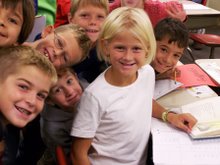During Social Studies class today I was able to connect with the students’ lives beyond school even more. Ms. A’s class was going over their Daily Geography as a group. The students have been learning to use map keys and determining the scale of a map to discover distances between locations. After one student provided the class with the correct answer she asked her to explain to the class how she determined that distance. Rather than explaining the appropriate steps she said she typed it into MapQuest to get the answer. This technique further emphasizes the lives of these students. Not only do many students not have computer/internet access at home, but also many have never heard of MapQuest. This further emphasized to me the importance of being aware of students’ background and their experiences. Without knowing this information, it can be difficult to provide students with appropriate instruction.
Saturday, February 10, 2007
Classroom Observation Reflection: February 2nd, 2007, 10:10am-2:15pm
Classroom Observation Reflection: January 26th, 2007, 9:00am-12:00pm
My observation from today will strongly help inform my future planning for this group of students. Kristin and I will be teaching a math unit between March 12th and March 21st. Observing Ms. A’s fifth grade math class gave me an idea of what to expect from these students both academically and socially.
There are two math classes—one from 9:40 to 10:35 and the other between 10:35 and 11:30. The first class consists of students whom are at grade level and the second section is those whom are at a fifth/sixth grade level. The work and activities during these two classes were very similar, but the differences in behavior and the general environment were apparent.
The high level section had 25 students, compared to 13 students in the other class. This larger class was more energetic and talkative. As a result, techniques such as turning off the lights to quiet the class were used. However, what was interesting was this class still managed to complete more tasks than the previous class. Despite their struggle to focus and behave in an appropriate manor, their math skills allowed Ms. A to get through more material and activities with the group.
When considering how Kristin and I will cater to the differences between the two classes a number of things come to my mind. We will not only be focusing on teaching the students new material, but we will also have to consider the behavior of students and how to minimize acting out. A new seating arrangement could be beneficial. I also think exploring behavior management techniques could come in handy.
Kristin and I will be teaching the same material to each of these classes, but our focus and expectations for each section will vary. We cannot expect to get through everything with the first class and therefore we will have to consider what we think is most important within the lesson and focus on that material first. Another thing we will have to consider is the class size. Because the grade level class is small and well behaved we may have more freedom to do hands-on activities. Creating one lesson that will cater to both sections and guarantee an understanding of the material is going to be most difficult task when coming up with a lesson plan.
